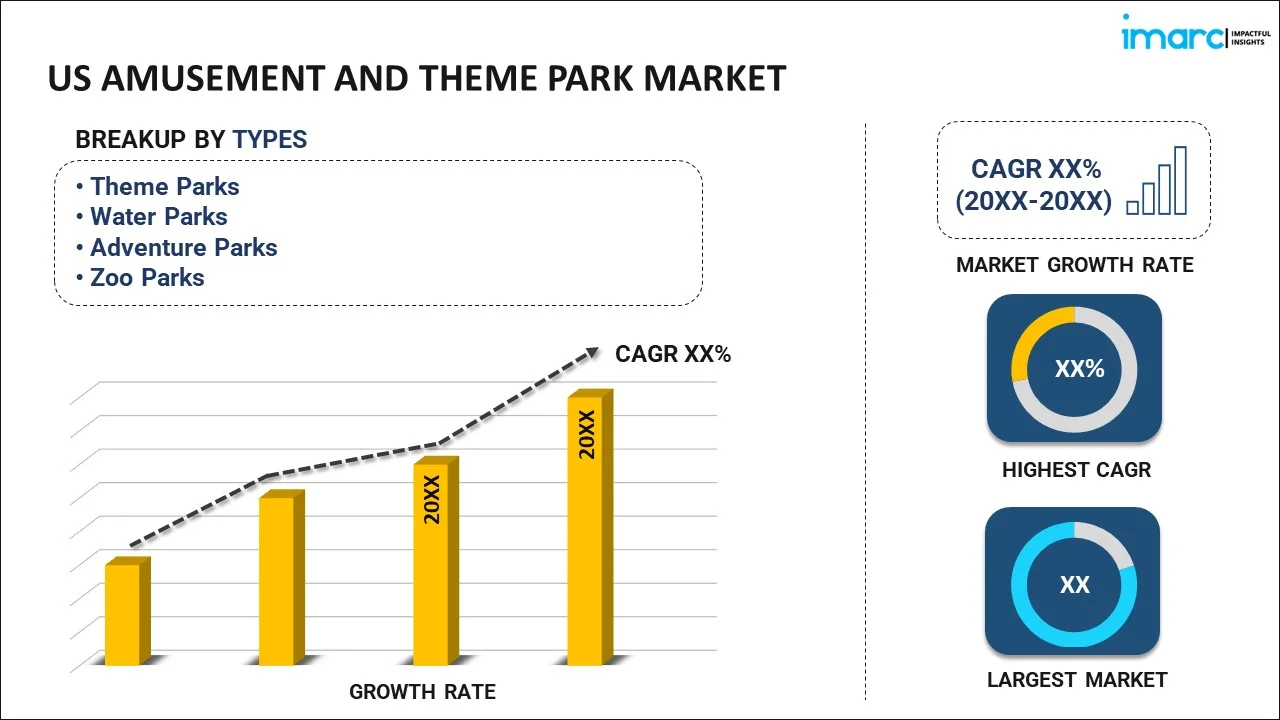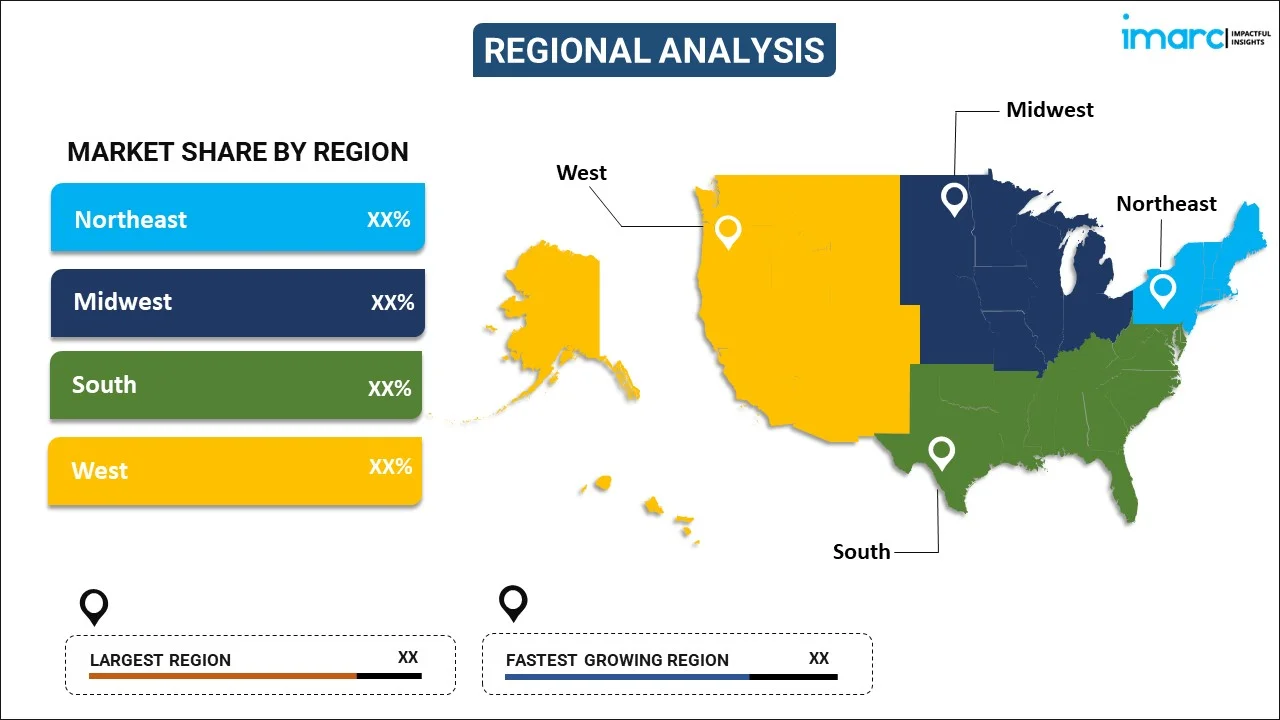
US Amusement and Theme Park Market Report by Type (Theme Parks, Water Parks, Adventure Parks, Zoo Parks), Rides (Mechanical Rides, Water Rides), Age (Up to 18 Years, 19 to 35 Years, 36 to 50 Years, 51 to 65 Years, More Than 65 Years), Revenue (Tickets, Food and Beverage, Merchandise, Hospitality, and Others), and Region 2024-2032
US Amusement and Theme Park Market Overview:
The US amusement and theme park market is projected to exhibit a growth rate (CAGR) of 3.70% during 2024-2032. The increasing consumer spending on leisure activities, advancements in ride and attraction technologies, the rise of experiential entertainment, and the implementation of targeted marketing campaigns and seasonal events to attract visitors year-round are some of the major factors strengthening the market growth.
|
Report Attribute
|
Key Statistics
|
|---|---|
|
Base Year
|
2023 |
|
Forecast Years
|
2024-2032
|
|
Historical Years
|
2018-2023
|
| Market Growth Rate (2024-2032) | 3.70% |
US Amusement and Theme Park Market Trends:
Integration of cutting-edge technology
The theme park and amusement industries are being revolutionized by the incorporation of cutting-edge technology. Parks are increasingly adopting advanced technologies such as virtual reality (VR), augmented reality (AR), and artificial intelligence (AI) to enhance the guest experience. VR and AR are being used to create immersive rides and attractions that transport visitors to entirely new worlds, offering unique and personalized experiences. For instance, AI is employed to improve visitor interactions, and Six Flags is going through a "complete digital transformation." The company's app and website now feature an AI-powered digital concierge in addition to improvements to rides and general operations. The implementation of these technologies to attract tech-savvy visitors and set parks apart in a competitive market is supporting the market growth.
Rise of immersive and experiential entertainment
A compelling story or adventure is a key component that attracts visitors who are looking for more than just rides. Parks are responding by developing highly themed lands and attractions that offer immersive experiences based on popular movies, TV shows, and video games. For example, the opening of Star Wars: Galaxy's Edge at Disneyland and Disney World provides fans with the opportunity to step into the Star Wars universe, complete with interactive elements, themed merchandise, and dining experiences. Similarly, Universal Studios' Wizarding World of Harry Potter draws crowds with its detailed recreations of iconic locations from the franchise. These immersive environments encourage longer stays, repeat visits, and increased spending on themed merchandise and food, significantly boosting park revenues and thus bolstering the market growth.
Emphasis on seasonal events and themed attractions
Parks are increasingly hosting seasonal events such as Halloween horror nights, Christmas celebrations, and summer festivals to attract guests during traditionally off-peak times. These events feature exclusive entertainment, themed decorations, and unique experiences that create a sense of urgency and excitement. For instance, Halloween events often include haunted houses, scare zones, and nighttime shows, attracting thrill-seekers and families alike. Christmas events offer festive parades, light displays, and holiday-themed shows. By continuously introducing new and varied events, parks can maintain visitor interest and drive attendance across different seasons. Additionally, themed attractions and limited-time events capitalize on current trends and popular culture, drawing in fans and generating media buzz. This strategy helps diversify the visitor base and ensures a steady flow of guests year-round, contributing to the market expansion.
US Amusement and Theme Park Market News:
- In July 2023, A $2 billion Americana-themed amusement park, the American Heartland Theme Park and Resort is set to open in 2026 in northeast Oklahoma near Route 66. Comparable in size to Disney World's Magic Kingdom and Disneyland, the 1,000-acre park aims to attract global visitors to celebrate America's cultures and values.
US Amusement and Theme Park Market Segmentation:
IMARC Group provides an analysis of the key trends in each segment of the market, along with forecasts at the country level for 2024-2032. Our report has categorized the market based on type, rides, age, and revenue.
Type Insights:

- Theme Parks
- Water Parks
- Adventure Parks
- Zoo Parks
The report has provided a detailed breakup and analysis of the market based on the type. This includes theme parks, water parks, adventure parks, and zoo parks.
Rides Insights:
- Mechanical Rides
- Water Rides
A detailed breakup and analysis of the market based on the rides have also been provided in the report. This includes mechanical rides and water rides.
Age Insights:
- Up to 18 Years
- 19 to 35 Years
- 36 to 50 Years
- 51 to 65 Years
- More Than 65 Years
The report has provided a detailed breakup and analysis of the market based on the age. This includes up to 18 years, 19 to 35 years, 36 to 50 years, 51 to 65 years, and more than 65 years.
Revenue Insights:
- Tickets
- Food and Beverage
- Merchandise
- Hospitality
- Others
A detailed breakup and analysis of the market based on the revenue have also been provided in the report. This includes tickets, food and beverage, merchandise, hospitality, and others.
Regional Insights:

- Northeast
- Midwest
- South
- West
The report has also provided a comprehensive analysis of all the major regional markets, which include the Northeast, Midwest, South, and West.
Competitive Landscape:
The market research report has also provided a comprehensive analysis of the competitive landscape. Competitive analysis such as market structure, key player positioning, top winning strategies, competitive dashboard, and company evaluation quadrant has been covered in the report. Also, detailed profiles of all major companies have been provided.
US Amusement and Theme Park Market Report Coverage:
| Report Features | Details |
|---|---|
| Base Year of the Analysis | 2023 |
| Historical Period | 2018-2023 |
| Forecast Period | 2024-2032 |
| Units | US$ Billion |
| Scope of the Report | Exploration of Historical Trends and Market Outlook, Industry Catalysts and Challenges, Segment-Wise Historical and Future Market Assessment:
|
| Types Covered | Theme Parks, Water Parks, Adventure Parks, Zoo Parks |
| Rides Covered | Mechanical Rides, Water Rides |
| Ages Covered | Up to 18 Years, 19 to 35 Years, 36 to 50 Years, 51 to 65 Years, More Than 65 Years |
| Revenues Covered | Tickets, Food and Beverage, Merchandise, Hospitality, Others |
| Regions Covered | Northeast, Midwest, South, West |
| Customization Scope | 10% Free Customization |
| Post-Sale Analyst Support | 10-12 Weeks |
| Delivery Format | PDF and Excel through Email (We can also provide the editable version of the report in PPT/Word format on special request) |
Key Questions Answered in This Report:
- How has the US amusement and theme park market performed so far and how will it perform in the coming years?
- What has been the impact of COVID-19 on the US amusement and theme park market?
- What is the breakup of the US amusement and theme park market on the basis of type?
- What is the breakup of the US amusement and theme park market on the basis of rides?
- What is the breakup of the US amusement and theme park market on the basis of age?
- What is the breakup of the US amusement and theme park market on the basis of revenue?
- What are the various stages in the value chain of the US amusement and theme park market?
- What are the key driving factors and challenges in the US amusement and theme park?
- What is the structure of the US amusement and theme park market and who are the key players?
- What is the degree of competition in the US amusement and theme park market?
Key Benefits for Stakeholders:
- IMARC’s industry report offers a comprehensive quantitative analysis of various market segments, historical and current market trends, market forecasts, and dynamics of the US amusement and theme park market from 2018-2032.
- The research report provides the latest information on the market drivers, challenges, and opportunities in the US amusement and theme park market.
- Porter's five forces analysis assist stakeholders in assessing the impact of new entrants, competitive rivalry, supplier power, buyer power, and the threat of substitution. It helps stakeholders to analyze the level of competition within the US amusement and theme park industry and its attractiveness.
- Competitive landscape allows stakeholders to understand their competitive environment and provides an insight into the current positions of key players in the market.
Need more help?
- Speak to our experienced analysts for insights on the current market scenarios.
- Include additional segments and countries to customize the report as per your requirement.
- Gain an unparalleled competitive advantage in your domain by understanding how to utilize the report and positively impacting your operations and revenue.
- For further assistance, please connect with our analysts.
 Inquire Before Buying
Inquire Before Buying
 Speak to an Analyst
Speak to an Analyst
 Request Brochure
Request Brochure
 Request Customization
Request Customization




.webp)




.webp)












